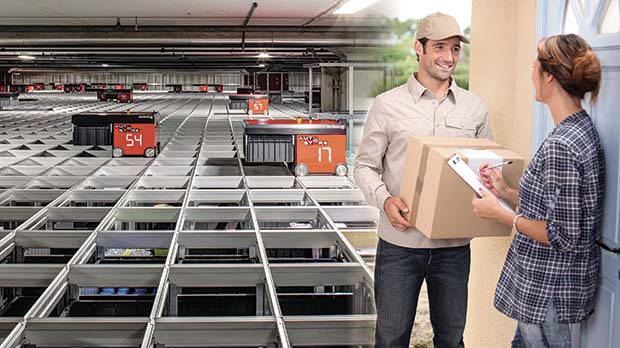As delivery times grow shorter, digital commerce is becoming ever more dynamic. To keep pace with these developments, businesses have to rethink and invest in new logistics concepts. The challenge today is to complete picking, packaging and shipping within a few short hours.

When ecommerce was in its infancy, online shoppers were impressed with being able to get a wide range of items delivered straight to their door, let alone find them there within a few days. Businesses grappled with the idea of how to shorten the time it took to turn clicks into picks, as well as deliver the goods profitably and at speed.
By 1999, bookshop chain co-founder, Louis Borders, launched Webvan in the US, which gave a glimpse into the future potential of home delivery. At its peak, it offered customers in ten US markets a 30-minute delivery window of their choice, yet by 2001, went bankrupt in a manner described as ‘the largest dot-com flop in history’.
As technology has become more familiar, and online retail has been accepted as the norm, the range of products available in many different channels has grown rapidly. Smartphones and tablets have made the process simpler, whilst expectations have been raised, fundamentally changing customer demands.
Online shoppers buying clothing, food or entertainment expect their purchase to be delivered within 24 hours, or better yet, on the same day. In light of the increasing willingness shoppers have shown to pay extra for expedited delivery, e-commerce providers now have a unique opportunity to boost online sales with short-tail items.
By 2020, it is thought that the same-day delivery of products purchased online will make up 15 percent of revenues in the parcel delivery industry, with a total market potential of 3 billion Euros in Western Europe.
However, online retailers and their logistics providers still face enormous obstacles in becoming ‘same day’ ready. On the one hand, such deliveries are economically feasible if the corresponding sales volume is sufficiently large; on the other, there are physical and geographic limitations on offering such a service. Retailers are having to develop concepts that enable them to bring customers even closer to their intended delivery, accounting for the increase in ‘Click and Collect’ style services. By collecting in store, retailers are hoping that customers will purchase other unplanned items upon collection. In addition, Click and Collect operations not only fit with current supply chain models, as retailers are already delivering to store, but are also more straightforward than delivering to people’s homes.
Most significantly, online retailers are being challenged to develop forward-thinking warehouse and delivery networks and to come up with flexible, real-time logistics concepts.
Paper-supported picking methods and the batching of orders during the picking process; media discontinuity between order and logistics systems; overnight billing runs – all these common order processing activities, found throughout the industry, no longer work in the high-speed world of same-day delivery.
Offering a steadily growing portfolio of solutions for the e-commerce sector, intralogistics system provider Swisslog has demonstrated in many projects that it is able to meet these new industry challenges head-on, with fast, highly flexible and future-proof logistics solutions. The key selling points are reliability and scalability, giving customers the confidence to invest in systems that allow them to adapt to the demands of the market.
The concept for success is easy to describe: Swisslog combines conveyor and warehouse technology, warehouse management software, preconfigured systems such as AutoStore, SmartCarrier and CarryPick, as well as extensive industry experience, into customised logistics solutions for state-of-the-art commerce.
At the heart of Swisslog’s concept for e-commerce businesses is the modular Click&Pick solutions portfolio. This enables companies to achieve fulfilment cycles of only a few minutes from order placement to picking. The solutions concept has made order fulfilment five times faster in many operations, whilst employees benefit from a quieter, more ergonomic and safer working environment.
AutoStore, Swisslog’s robot-assisted small-parts warehouse system, gives customers in the e-commerce sector the ability to respond quickly and flexibly to increased demand even if space is limited. In the aisle-free and highly dynamic warehouse system, robots can transport bins from storage locations to integrated picking stations in a matter of seconds. The system combines the ability to perform high-speed picking with the benefits offered by the process-oriented use of space. In times when businesses need flexible and fast solutions, experts clearly recognise the competitive advantage provided by this approach.
The newest member of the Click&Pick portfolio is the CarryPick system. This offers a combination of state-of-the-art software control, mobile racks, robots and multi-functional workstations. In this concept, the racks stocked with goods are picked up by robots and transported automatically to the picking stations. The system offers extremely high picking throughput, even at peak times, and offers the major advantage of replenishing the movable racks with new or returned goods, once orders are fulfilled.
“A change in customer lifestyles and Internet advances meant expectations were high but delivery poor,” says Swisslog’s UK Managing Director, James Sharples. “Now we are approaching the tipping point as customers attitudes align with the capabilities of grocery retailers such as Ocado, Peapod, Mathem, even Amazon.”
eBay may present a new challenge. The online retailer is currently trialing same-day delivery in the US, via the mobile eBay Now app. For those that remain unconvinced about the way things are heading, this final statistic may give you pause for thought. According to the news agency www.xinhuanet.com there were 242 million people shopping online in China in 2012. That growth shows no sign of slowing.
“One thing is for certain,” concludes James, “customer expectations, reliability, delivery speeds and the search for a competitive advantage is only going to add more demands on the warehouse of the future.”
Emma Daniels, Head of Marketing (EMEA)
Tel: 01527 55 1600
Email: emma.rawlinson@swisslog.com




Comments are closed.